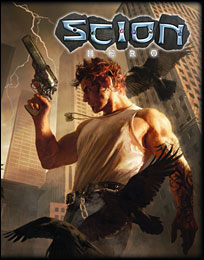Differences between editions
Scion changed drastically between its first and second editions. While the first edition presented an Earth effectively identical to the real one, the second presented instead a setting literally referred to as "The World," [2] wherein Abrahamic faiths did not so completely overtake Europe, let alone the rest of the world. As such, while The World is much like the real world on a surface level, other pantheons are still widely recognized and worshiped throughout. Further, the existence of gods and other supernatural entities is presented as generally acknowledged as fact rather than faith, although rarely present in anyone's day-to-day life.
With the updated Storypath system, the mechanism of advancement has changed; Scion players accumulate Experience and grow in power though Deeds, goals for their characters to experience or accomplish. While Legend continues to be the most significant measure of a Scion's growing power, and still measures the thresholds past which a Hero becomes a Demigod, and then a full-fledged deity, it is no longer increased by the expenditure of experience points but directly by the accomplishment of deeds.
The nature of demigod-hood has significantly altered: while previously it was a relatively natural progression of power that had few survivors merely owing to increasing scope of danger in a growing war against the Titans, the second edition plays up the liminal state of Demigods by making it explicitly temporary: A scion who has moved beyond being a "mere" Hero finds herself on the road to apotheosis, passing through a series of trials and constructing a larger-than-life mythic identity called a Mantle in the process. While Heroes can theoretically return from death, a Demigod who passes a certain point of advancement can no longer do so; should they die, it becomes the natural terminus of their story. As such, some mortal cultural heroes are demigods in-setting, whose deaths and failures marked where their own pursuit of godhood failed. They have left behind their incomplete Mantles, however; a hero who wishes to do so may take one up and try to complete it, succeeding where their predecessor failed, overwriting their death with the new hero's own triumph and becoming the deity that the initial hero wanted to be. A scion may also, at the point of apotheosis, try to take the identity of an existing god, either by wresting it from them, accepting a lesser mantle from that god, or by surrendering their identity, effectively declaring that they were always an incarnation of that deity.
The options of player characters has also greatly diversified, with more human options such as prophets, sorcerers, and saints, as well as supernatural entities such as Kitsune, Satyrs, and skin-changing Therianthropes, who may or may not claim patronage or descent from a higher power. Even the Scions themselves have become more diverse: instead of being universally blood descendants of the gods, they may now include those who have been chosen by the god (gaining their favor either by an affinity of fate or a special bloodline), created whole cloth, or even an Incarnate Scion: a mortal guise of a deceased god in the world.
The nature of the relationship between the world, the Gods, and Fate has altered: as the Gods create myths of themselves, they alter the world not just going forward, but retroactively: a newly ascended god may find herself in her pantheon's prayers and traditions going back centuries before her birth. Such myths can birth new facets of a deity; many gods have developed multiple Mantles over time. This process gave rise, in-setting, to the Loa from the Orisha, and likewise covers the correspondence between the Greek and Roman gods.
Furthermore, while the Titans still exist, they are less universally antagonistic: while the Greek Theoi regard them largely as dangerous foes who must be opposed, the Shen of China are more inclined to try to incorporate them into their hierarchy and give them a job and purpose within the Celestial Bureaucracy, while the Orisha explicitly regard the difference as no more than a political designation for enemies rather than a term possessing any material or metaphysical distinction. The game explicitly intends for the presentation and relevance of antagonistic titans to be to adjustable to a given group's tastes. [3]
In the Titanomachy sourcebook the titans and their relationship to the gods is given a spotlight. While the previous edition allowed the Titans to "adopt" a willing scion of a god as one of their own, they may now create progeny directly in the same ways as the gods; these children can join the ranks of their parents just like the progeny of the divine can. Even fallen titans (such as Ymir) may return if a Titanic scion assumes their Mantle, while the multiple facets of the gods reflected in their Mantles means that some can exist as both God and Titan.
Dragons are also introduced as a new faction in the second edition, [4] here presented as pre-human entities whose reign was brought to an end by the ascendance of the gods and humanity. Dragons are greatly focused on memory: resistant to the rewriting of history that the gods do, they remember all pasts that were, and even slain dragons still exist in a communal pool of memories. They exist in hiding, grouped into Flights (based both on philosophy and geography) and work through Heirs—humans who have been bestowed a fragment of a Dragon's might, analogous to divine Scions—who can ultimately embrace that power, shed their humanity, and join the ranks of their patron. Much like titans, deceased dragons can return from death if an heir decides to become that dragon upon their final ascension.
